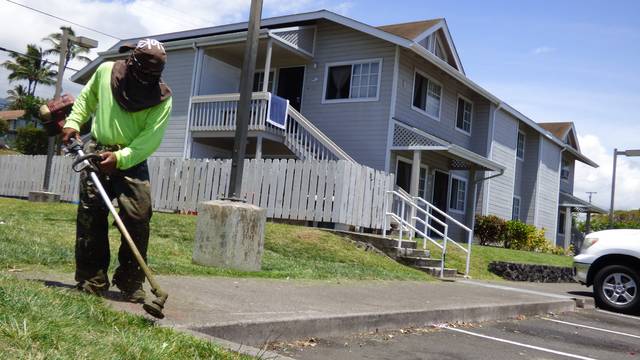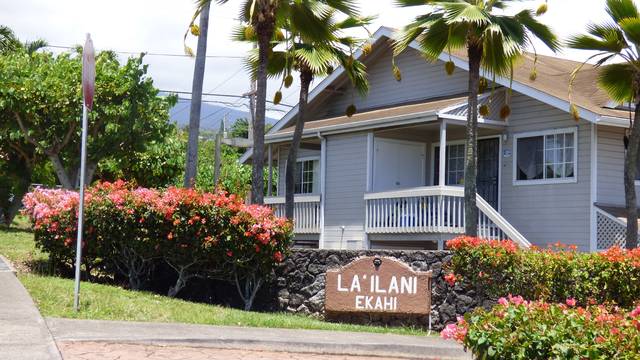State plans sale of 6 affordable housing complexes across three islands
KAILUA-KONA — The Hawaii Housing Finance and Development Corporation is moving forward with plans to sell six state-owned affordable housing properties on three different islands to a private buyer.
The state agency — connected to the Department of Business, Economic Development and Tourism — is hoping to initiate an RFP process by the fourth quarter of 2017 and select a buyer by early 2018 to assume management of the properties.
“Over the years there’s been a lot of deferred maintenance on the properties, partly because the state never raised the rent and there aren’t enough reserves to fix all these things,” said Kent Miyasaki, state housing information specialist. “We’re looking at getting a private buyer in to commit to fixing all the deferred maintenance. It’s just much, much more efficient for a private company to come in and handle all that.”
The one Big Island property up for sale is La’ilani Apartments in Kailua-Kona with 200 famil y units.
The others include Kamakee Vista with 226 units, Kauhale Kakaako with 268 family units, and Pohulani with 263 senior units — all located in Kakaako, Oahu. Kekuilani Courts with 80 family units is located in Kapolei, Oahu. The final property is Honokowai Kauhale with 184 family units, which is located in West Maui.
The average age of the properties is 26 years. Because the complexes were all funded together, they will also all be sold together.
All six affordable rental properties were funded under the same bond program aimed at the 80-100 percent average median income (AMI) gap — essentially a group of gainfully employed residents of Hawaii who can afford reasonable rents but don’t typically earn enough to afford the purchase of a home.
Rental rates on the units at all six complexes are determined by affordability guidelines set and updated annually by the United States Department of Housing and Urban Development (HUD).
For instance, a household on Hawaii Island earning 80 percent of the AMI would pay $1,045 monthly for a one-bedroom unit or $1,448 for a three-bedroom unit based on the 2016 guidelines.
A household earning 100 percent of the AMI — or making the average median income for Hawaii Island — would pay $1,306 for a one-bedroom unit and $1,810 for a three-bedroom unit. Affordable rental prices vary from island to island and are higher on Oahu and Maui.
Miyasaki said over the years, however, rental rates at the six properties have dropped below those thresholds, meaning some tenants are paying less than they could be charged. This, in part, is what has caused each of the properties to fall into various stages of disrepair.
He said the state’s goal is to preserve the six projects as financing programs to support housing for the 80-100 percent AMI gap no longer exists. Affordable housing financing is now geared toward projects like Kamakana Villages in West Hawaii, which are focused on the 60 percent AMI gap and below — or people who struggle mightily to afford rent of any kind in Hawaii’s expensive housing market.
To ensure the complexes’ preservation, a private company needs to be brought in, Miyasaki said. It’s a development that has some tenants at La’ilani, several of whom are seniors on fixed incomes, concerned about what the privatization of their state-owned affordable units means for rents moving forward.
“There are people who are afraid, worried they will end up on the street,” said John Dow, a married father of three who rents a three-bedroom unit at La’ilani. “And if this is affordable housing, where are you going? Now more than ever, we need communities like this.”
Dow said Miyasaki explained to him and several others at a meeting earlier this month that some tenants paying well below the prices established by HUD may eventually see a monthly increase upward of $500, though that would not be immediate.
Miyasaki admitted privatization will drive up rental prices but said there are several safeguards in place to mitigate inevitable hikes.
First, the state will still own the land and is selling only the buildings to a private entity. Because of that, the state will be able to write affordability stipulations into the 75-year lease it plans to offer potential buyers.
The state will pay off the bonds that funded the project with the profits from the sale, using whatever is left to aid a longstanding rental assistance program to tenants across the six properties, some of whom have been able to earn up to $175 in monthly rental credits through the program.
Firm stipulations Miyasaki said will be included in the lease contract with whatever company purchases the properties are maximum rental price increases of 2 percent each year for the next five years and the guaranteed continuation of the rental assistance program for the next decade.
“That increase over a five-year period is negatable,” Dow said. “It’s what happens after five years. I personally do not plan to be here. I want to be a homeowner within the next five years, but some people have been here for two decades. What about them?”
Miyasaki explained that after five years is up, the new owner of the properties will be able to more aggressively raise rents to make sure each tenant is paying an amount in accordance with HUD guidelines for the 80-100 percent AMI gap. Miyasaki explained such was always the intention for the properties and not every tenant is currently paying the maximum rates they could legally be charged.
Of the 200 tenants at La’ilani, 60 receive rental assistance and are paying below the HUD rates established for those making 80 percent of the AMI on Hawaii Island — the lowest rates ever intended for the project.
They will be most affected when rents are all increased to match the 80-100 percent AMI gap standards, regardless if some tenants, who are perhaps on fixed incomes, don’t earn enough money to place them in the 80-100 percent range. The other 140 tenants already pay rates commensurate with HUD standards.
HUD standards will continue to cap rates moving forward over the last 70 years of the lease, which Miyasaki hopes will ease some tenant concern.
“Rents will never (exceed) that 100 percent limit, which HUD adjusts every year,” Miyasaki said. “Sometimes that 100 percent (price point) goes up, other times it goes down.”




